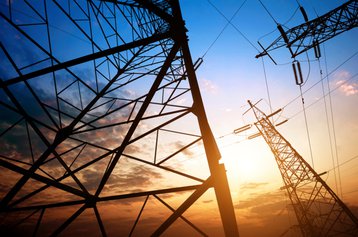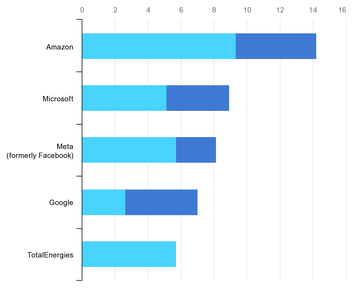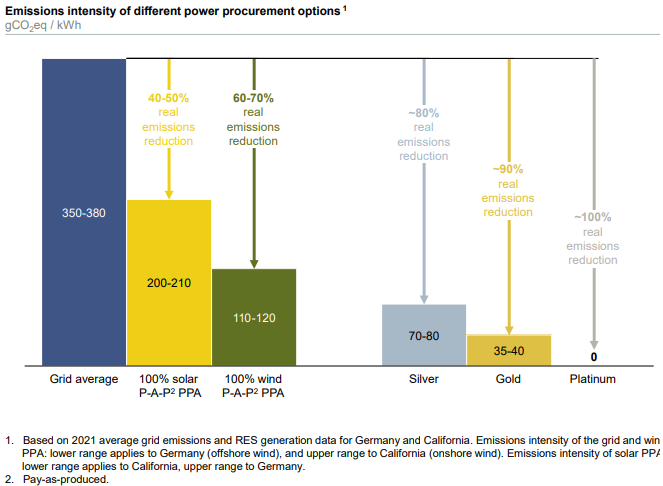The pandemic has brought about rapid digital transformation. We're spending more of our lives online than ever, and the ICT sector is at the heart of this digital transformation. Data centers and transmission networks are essential parts of this evolution in society, yet they also consume valuable finite resources, such as electricity and water.
The depletion of resources is a pressing issue, but change is already happening to address this from within digital industries. Data centers and transmission networks can become critical enablers of the transition toward a decarbonized economy.
In this article, we will focus on what leading data center companies are doing to completely eliminate indirect emissions from electricity consumption, the so-called Scope 2 emissions by the Greenhouse Gas (GHG) Protocol. We will also debunk the myth around “100 percent renewable energy” claims and explain why data center operators will want to fully decarbonize their electricity purchasing strategy. Finally, we will touch upon how to begin a decarbonization journey.
Electricity use in the data center
According to a recent report published by the International Energy Agency, data center power consumption increased by more than 60 percent between 2015 and 2021. Transmission networks are using even more power, also growing their usage by up to 60 percent.
This figure excludes crypto mining activities that are believed to be using half of the power of all data centers worldwide.
The IEA estimates that the data centers and data transmission networks that underpin digitalization accounted for around 300 Mt CO2-equivalent in 2020 (including embodied emissions), eqauting to 0.9 percent of energy-related greenhouse gas emissions (or 0.6 percent of total GHG emissions). Not surprisingly, data centers have come under much scrutiny as a result, with restrictions on new build data center builds being introduced in some places, such as Ireland.
Data centers beyond efficiency and 100 percent renewable energy claims
The numbers above show that energy efficiency improvements can’t be the only way to reduce a data center's climate impact.
Low-carbon or carbon-free electricity procurement is another key tactic the industry uses to reduce Scope 2 emissions. There are several market-based options for data centers to procure clean electricity, including virtual or physical corporate power purchase agreements (PPAs), on-site generation, green tariffs, and renewable energy certificates (also known as EACs, GOs, RECs, REGOs, and I-RECs, depending on local standards).
The data center sector has been a core driver of renewable energy sourcing over the past decade. Between 2010 and 2021, tech giants like Amazon, Google, and Meta (Facebook) were among the top five clean energy buyers. All three have significant data center operations.
Yet, apart from a few revolutionary front runners (like Google, Microsoft, and Iron Mountain) many data centers still rely on an annual carbon accounting framework to validate their renewable energy claims.
The truth behind the 100 percent renewable energy claims
So far, most companies that procure renewable energy are buying a volume of electricity that matches their annual consumption to a certain extent. The purchase can cover 40, 60, and up to 100 percent of their yearly consumption. This approach, which finds its leading promoters in the RE100 initiative by The Climate Group, has helped the renewable energy market to experience tremendous growth over the last decade.
However, several recent publications claim that this approach doesn’t consider the physical reality of the power grid with enough precision. For example, a Dutch colocation center could claim to be ‘100 percent renewable’ while covering its annual consumption by buying an equal volume of energy certificates, of 1MWh each, generated by a solar plant in Portugal. Now, it’s not hard to understand that:
- The colocation center is likely to also use electricity during the night, while the solar plant in Portugal won’t be generating any clean electrons;
- The electrons injected into the Portuguese grid are unlikely to reach the Netherlands;
- The local (Dutch) power grid mix fluctuation is not considered. The sun is not always shining (especially in The Netherlands), and the wind isn’t always blowing!
So, while a market-based approach is crucial for the progress of the global renewable energy goals, its reliance on annual data and averages undermines its credibility and ability to deliver a decarbonized economy.
Fortunately, there are a number of opportunities to turn this challenging situation around.
The energy industry has evolved. The sector's digitalization has brought about next-generation energy procurement approaches that can harness the immense power of more precise energy and carbon data. As a result, achieving the complete decarbonization of electricity supply is now absolutely possible.
Embracing the 24/7 carbon-free energy journey
Data centers now have an opportunity to maximize the decarbonization impact of their energy procurement. Industry players such as Google, Microsoft, and Iron Mountain Data Centers can provide a source of inspiration. These market leaders set the goal of transitioning from ‘100 percent renewable energy’ annually to 24/7 Carbon-free Energy, or CFE.
Such a strategy leverages the automated collection of granular customer energy (generation and consumption) and granular grid data (hourly carbon intensity of the grid) to unleash the full decarbonization potential of corporate energy procurement.
These players have adopted this strategy because they recognize that matching on an annual basis isn't enough to fully decarbonize the electricity grid on a global scale. A recent report by McKinsey & Co (chart above) found that an annually matched solar PPA, which enables ‘100 percent renewable’ claims, can have an average hourly match ranging between 40-to-50 percent; a ‘100 percent renewable’ wind PPA is believed to perform better and be matched to between 60 and 70 percent hourly.
On the other hand, just a tailored, hourly approach can achieve a 100 percent reduction of the emissions of such a contract (three columns on the right side of the chart).
However, as you can see from Google's results, achieving 24/7 carbon-free energy all year round (or 100 percent 24/7 CFE) is not an easy task for the present, but this shouldn't be the source of great distress. In order to create a benchmark, Google is currently at around 60-to-70 percent 24/7 CFE and planning to reach 100 percent 24/7 CFE by 2030 for its primary data center facilities.
A 24/7 CFE strategy is meant to be an incremental approach, made up of constant improvements. FlexiDAO’s CEO, Simone Accornero, discusses in more detail the Carbon-Aware Energy series recently published by the company, starting with ‘A New Frontier: Carbon-Aware Energy Procurement’.
Why 24/7 carbon-free energy?
The timely adoption of a next-generation carbon strategy such as 24/7 CFE brings several advantages. Most of them are related to the climate leadership opportunity that comes from such a forward-looking decision. Other advantages are related to anticipating regulatory changes and the shift in the global energy landscape.
Within the data center ecosystem, shifting towards a 24/7 carbon-free energy strategy is particularly interesting for colocation providers. Big hyperscalers — colocation providers' clients — increasingly require granular carbon emission data for increasing the transparency of their Scope 3 emissions accounting.
So, embracing a strategy that has its foundation in the usage of granular electricity and carbon data brings multiple benefits to the table; first movers will benefit from gaining a competitive advantage in the eyes of:
- Their clients who want to monitor their Scope 3 footprint so that they can reduce their impact through data-driven carbon-aware decision-making;
- Talent who want to work for a company that has a clear and inspiring climate agenda;
- ESG investors who require transparency on the score of the company they want to invest in.
Anticipating upcoming standards and regulations
Standard setters, regulators, and other initiatives already sent clear signals with regard to the role of 24/7 carbon-free energy in the future of the energy and sustainability landscape.
At an international level, last year the United Nations launched the UN 24/7 Carbon-Free Energy Compact to encourage high-level dialogue on this crucial strategy. More recently, ISO published its Net Zero Guidelines for companies and other organizations aiming to set such a target in their sustainability agenda.
ISO’s standard makes a clear reference to 24/7 CFE under 8.2.4 Targets for Scope 2 emissions: "Governance organizations, and other organizations if appropriate, should set targets to promote the availability of low carbon (non-fossil) or appropriate renewable energy for every hour of every day, to motivate a wholesale clean energy transformation."
Several regulatory bodies, like the Securities and Exchange Commission in the US and the EU Commission, have now proposed new requirements for climate-related disclosures. The International Sustainability Standards Board has done the same at a global level.
Interestingly, the common denominator in each of these proposals is that they build on the Greenhouse Gas (GHG) Protocol, which is currently under review for additional guidance to be added. There are calls from numerous thought leaders (ENTSO-E, CEBI pg. 32, Clean Air Task Force) for the protocol to include more granular Scope 2 requirements, with proposals expressing how the GHG Protocol should consider the CO2 content of electricity procurement on a tighter geographical and temporal basis.
At a European level, the EU Commission set out actions to digitalize the energy sector to improve efficiency and integration of renewables. In the document, they dedicated a special section to data centers saying that they will introduce “separate reporting lines for indirect GHG emissions from purchase of cloud computing and data center services in EU sustainability standards under the Corporate Sustainability Reporting Directive (CSRD).”
CSRD, it should be noted, was approved this month.
Enabling your 24/7 CFE strategy
As mentioned above, accessing reliable and granular energy data is necessary to begin the evolution towards being “green” every hour of the day and to begin confidently reducing your emissions impact.
At FlexiDAO, we enable companies to transition to a 24/7 carbon-free energy strategy by leveraging our blockchain-based electricity and carbon emissions traceability and certification software.
As part of the EnergyTag initiative, we're performing 24/7 matching for Microsoft's data centers in the Netherlands, and providing the same service for Google’s facilities in three different European countries. Their data centers’ power consumption will be 'hourly matched' with the real-time production of selected clean electricity generation assets.
Our software provides the project with tools that enable the traceability of clean electricity production and consumption, plus its hourly carbon intensity, without installing additional hardware devices.
Our software solution also assists data centers in certifying this data following EnergyTag guidelines for granular certification, which aids in measuring the data center's decarbonization impact and enabling confident climate communication. This will position you among the energy leaders in the industry and avoiding undesirable costs from upcoming carbon regulation.
If you want to begin your 24/7 Carbon-free Energy journey, try our new free tool, CFEscore. It will help you estimate how green the electricity you are currently buying and consuming is.
The energy game is changing and, as large energy buyers, data centers are in prime position to harness this change. By reducing their carbon impact on an hourly basis, they can show genuine climate leadership in a rapidly evolving industry and stay on the right side of a shifting energy and sustainability reporting landscape.






